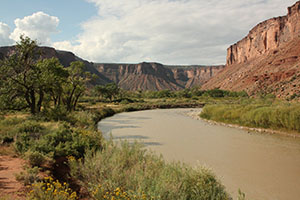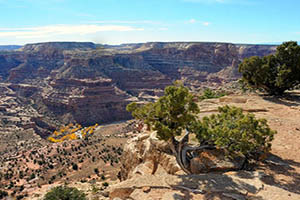Take Action Now: Comment Period Open for Labyrinth Canyon Travel Plan!
A Once-in-a-Generation Opportunity
Off-road vehicle (ORV) use on public lands in Utah has risen exponentially in recent years, to the detriment of wilderness, wildlife, and other recreationists.
 Now, the Bureau of Land Management (BLM) is in the process of determining where off-road vehicles are allowed in some of Utah’s most stunning and remote wild lands.
Now, the Bureau of Land Management (BLM) is in the process of determining where off-road vehicles are allowed in some of Utah’s most stunning and remote wild lands.
Travel plans are an opportunity to develop reasonable, balanced, and forward-thinking blueprints that ensure public access while preserving the backcountry and minimizing damage. The travel planning process gives the BLM a chance to get things right by providing access to trailheads, scenic overlooks, and recreation opportunities while protecting the reason people want to drive to such remote areas in the first place: to enjoy the unspoiled beauty of Utah’s unparalleled public lands and wilderness areas.
Plans with open comment periods
| Labyrinth Rims/Gemini Bridges Scoping Phase: Complete Comment Period Open on Draft Plan Expected Final Plan: June 2023  |
All plans in process or scheduled for release (alphabetical)
| Book Cliffs Scoping Phase: Complete Next Up: Draft Plan Expected Final Plan: Summer 2023  |
Dinosaur North Scoping Phase: Complete Next Up: Draft Plan Expected Final Plan: May 2023  |
Dolores Triangle Scoping Phase: TBD Next Up: Draft Plan Expected Final Plan: June 2025  |
| Henry Mountains Scoping Phase: TBD Next Up: Draft Plan Expected Final Plan: Early 2024  |
Labyrinth Rims/Gemini Bridges Scoping Phase: Complete Comment Period Open on Draft Plan Expected Final Plan: June 2023  |
Nine Mile Scoping Phase: TBD Next Up: Draft Plan Expected Final Plan: June 2024  |
| Paunsaugunt Scoping Phase: Complete Next Up: Draft Plan Expected Final Plan: June 2023  |
San Rafael Swell Scoping Phase: Complete Next Up: Draft Plan Expected Final Plan: Spring 2024  |
Trail Canyon Scoping Phase: Complete Next Up: Draft Plan Expected Final Plan: Summer 2023  |
Learn More About the Planning Process
How We Got Here
For decades, the BLM did little to regulate the use of ORVs on public lands. In spite of wilderness areas being closed to motorized recreation, the BLM allowed ORVs to run rampant within proposed wilderness areas. In 2008, BLM offices in Moab, Monticello, Richfield, Price, Vernal, and Kanab finally took a step in the right direction and issued travel plans that limited ORV use to designated routes. Unfortunately, these route designations failed to comply with federal laws enacted to protect archaeological resources. They also failed to comply with regulations that require ORV routes to be located to minimize impacts to natural and cultural resources and to minimize conflicts with other users.
As part of our litigation over six resource management plans issued under the George W. Bush administration (click here for background on this), SUWA challenged the six ORV travel plans. The federal district court agreed with SUWA that the BLM failed to comply with federal laws to protect public lands and resources from damage caused by ORVs.
Under a January 2017 settlement agreement, the BLM is required to complete 11 new ORV travel management plans by 2025, covering more than 6 million acres of BLM-managed lands in eastern and southern Utah. Prior to designating routes as open to ORVs, the BLM must expressly consider impacts to “lands with wilderness character,” sensitive natural resources, and cultural resources. The agency must also minimize impacts to those resources. The travel planning process is ongoing, and SUWA continues to work with the BLM to ensure the agency complies with its regulatory mandates.
Add your name to the petition below to tell the BLM to balance off-road vehicle use with the critical need to protect southern Utah’s redrock wilderness.
Our Ongoing Work to Protect the Redrock
SUWA is committed to ensuring that the wild country proposed for wilderness designation under America’s Red Rock Wilderness Act—and the streams, wildlife, soils, native plants, cultural sites, and solitude found there—are protected from ORV-related impacts. As part of this work we are:
- Participating in the BLM’s ongoing ORV travel planning. Through this process, SUWA is providing significant information about the condition of routes on the ground and potential impacts to natural and cultural resources.
- Providing the BLM and the public with information regarding the environmental and cultural resource impacts of ORV use and urging the agency to develop trail designations that make sense and also minimize impacts to natural and cultural resources.
- Assisting in the clean-up and restoration of ORV-damaged areas through stewardship projects with our members and partners in the conservation community.

